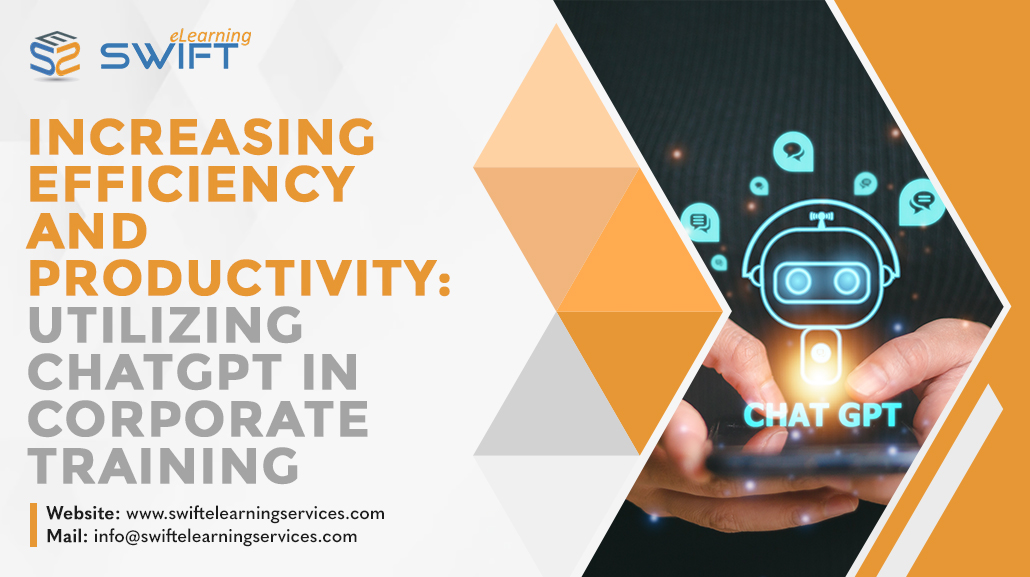Increasing Efficiency and Productivity: Utilizing ChatGPT in Corporate Training
Discover how incorporating ChatGPT in corporate training can revolutionize your organization, enhancing efficiency and productivity. Explore interactive learning, personalized support, and real-time troubleshooting for an engaging and effective training experience.
In today’s fast-paced corporate world, organizations are constantly striving to find ways to enhance efficiency and productivity. With advancements in technology, new solutions are emerging that can revolutionize corporate training and streamline operations. One such solution is ChatGPT, a powerful language model developed by OpenAI.
In this article, we will explore how utilizing ChatGPT in corporate training can significantly boost efficiency and productivity within organizations. Before that, let us first understand what corporate training is.
1. Understanding Corporate Training
Corporate training refers to the process of providing professional development opportunities to employees within an organization. It aims to enhance their skills, knowledge, and competencies, ultimately improving job performance and driving organizational success. Corporate training encompasses a wide range of learning initiatives, including workshops, seminars, online courses, and on-the-job training.
The benefits of corporate training are numerous and impactful. Here are some key advantages:
1.1 Skill Development
Corporate training helps employees acquire new skills and enhance existing ones. By providing targeted learning opportunities, employees gain the knowledge and expertise needed to excel in their roles. This leads to increased productivity and efficiency in performing job tasks.
1.2 Increased Job Satisfaction
When employees receive training and development opportunities, they feel valued by the organization. This boosts job satisfaction and motivation, as employees recognize that their growth is prioritized. As a result, they are more likely to remain engaged and committed to their work.
1.3 Improved Employee Performance
Well-trained employees are better equipped to perform their duties effectively. Through corporate training, employees gain a deeper understanding of their responsibilities, industry best practices, and emerging trends. This knowledge empowers them to make informed decisions, solve problems efficiently, and deliver high-quality work.
1.4 Enhanced Adaptability to Change
In today’s rapidly evolving business environment, organizations must adapt to technological advancements, market shifts, and industry disruptions. Corporate training equips employees with the skills necessary to embrace change and navigate challenges effectively. This adaptability enables organizations to stay competitive and agile.
1.5 Team Building and Collaboration
Corporate training often involves interactive activities and group exercises. These opportunities foster teamwork, collaboration, and communication among employees. As they learn together and engage in shared learning experiences, employees develop stronger relationships and synergy within teams.
1.6 Talent Retention and Attraction
Offering comprehensive training and development programs is attractive to potential employees. It signals that the organization values employee growth and invests in their professional development. Moreover, well-trained employees are more likely to stay with the organization, reducing turnover rates and the associated costs.
1.7 Compliance and Risk Management
In certain industries, compliance with regulations and industry standards is crucial. Corporate training ensures that employees are well-versed in compliance requirements, ethical guidelines, and safety protocols. This mitigates risks, protects the organization’s reputation, and avoids legal and financial consequences.
1.8 Innovation and Creativity
Continuous learning encourages employees to think critically, explore new ideas, and contribute to innovation within the organization. Training programs that foster creativity and innovation help employees develop a growth mindset, enabling them to identify opportunities, propose innovative solutions, and drive organizational success.
Literally, corporate training provides a multitude of benefits, including skill development, increased job satisfaction, improved performance, adaptability to change, team building, talent retention, compliance, and fostering innovation. By investing in employee training, organizations can cultivate a skilled workforce that contributes to long-term success and growth.
2. Leveraging ChatGPT for Corporate Training
2.1 Enhancing Employee Onboarding Process
The onboarding process plays a crucial role in integrating new employees into an organization. However, it can often be time-consuming and resource-intensive. By incorporating ChatGPT into the onboarding process, organizations can create interactive and personalized training modules.
New employees can engage with ChatGPT to receive instant responses to their queries, access training materials, and familiarize themselves with company policies. This streamlined onboarding experience ensures that employees hit the ground running and become productive members of the team more quickly.
2.2 Real-time Support and Troubleshooting
In a corporate setting, employees often encounter challenges and require immediate assistance to overcome them. With ChatGPT, organizations can provide real-time support and troubleshooting through chat-based interfaces.
Employees can interact with ChatGPT to receive guidance on technical issues, software usage, or any other queries they may have. This reduces dependence on support staff, minimizes downtime, and allows employees to resolve issues efficiently, thereby increasing overall productivity.
2.3 Personalized Learning Paths
Every employee has unique strengths, weaknesses, and learning styles. Traditional training programs often follow a one-size-fits-all approach, which may not cater to individual needs effectively.
By leveraging ChatGPT, organizations can develop personalized learning paths for employees. Based on their responses and interactions with ChatGPT, the system can tailor training materials and resources to match their specific requirements. This personalized approach ensures that employees receive targeted training, maximizing their learning outcomes and productivity.
2.4 Gamified Training Experiences
Engaging employees during training sessions can be a challenge. Traditional methods often lack interactivity and fail to capture employees’ attention fully. ChatGPT offers the opportunity to gamify training experiences. By incorporating elements of gamification, such as quizzes, challenges, and rewards, organizations can create an immersive and interactive learning environment.
This not only boosts employee engagement but also makes the training process more enjoyable and memorable, resulting in increased knowledge retention and enhanced productivity.
2.5 Multilingual Training Support
In today’s globalized business landscape, organizations often have a diverse workforce that speaks different languages. This language barrier can hinder effective communication and training delivery. However, ChatGPT’s language capabilities can bridge this gap.
By integrating multilingual support into ChatGPT, organizations can provide training materials and support in employees’ native languages. This ensures that language barriers do not impede the learning process, enabling employees to grasp concepts more easily and enhancing overall productivity.
3. Conclusion – Increasing Efficiency and Productivity: Utilizing ChatGPT in Corporate Training
Incorporating ChatGPT into corporate training programs can significantly enhance efficiency and productivity within organizations. By leveraging its interactive nature, personalized learning paths, and real-time support capabilities, organizations can create a more engaging and effective training experience for employees.
As technology continues to advance, embracing innovative solutions like ChatGPT will undoubtedly shape the future of corporate training.
4. FAQ’s About Increasing Efficiency and Productivity: Utilizing ChatGPT in Corporate Training
How does ChatGPT differ from traditional training methods?
ChatGPT differs from traditional training methods by offering interactive, personalized, and real-time training experiences. It leverages artificial intelligence and natural language processing to provide instant responses, tailored learning paths, and gamified training experiences, which traditional methods often lack.
Can ChatGPT replace human trainers in corporate training?
While ChatGPT can automate certain aspects of corporate training, it is not intended to replace human trainers entirely. Instead, it complements human trainers by providing real-time support, personalized learning paths, and on-demand access to training resources, thereby enhancing the overall training experience.
Is ChatGPT suitable for all types of organizations?
Yes, ChatGPT can be utilized by organizations of various sizes and industries. Whether it’s a small startup or a multinational corporation, ChatGPT can be customized to meet the specific training needs of any organization.
Are there any privacy concerns when using ChatGPT for training?
Organizations should prioritize data security and privacy when implementing ChatGPT for training. It is essential to ensure that sensitive information is protected and that proper data handling practices are in place. By following best practices for data security, organizations can mitigate potential privacy concerns.
Can ChatGPT be integrated with existing learning management systems (LMS)?
Yes, ChatGPT can be seamlessly integrated with existing LMS platforms. This integration allows organizations to leverage the power of ChatGPT while still utilizing their preferred learning management system for content delivery and tracking.
How can organizations measure the effectiveness of ChatGPT in corporate training?
Organizations can measure the effectiveness of ChatGPT in corporate training by tracking key performance indicators (KPIs) such as employee engagement, knowledge retention, training completion rates, and post-training productivity. Analyzing these metrics can provide insights into the impact of ChatGPT on training outcomes.






